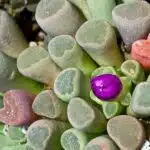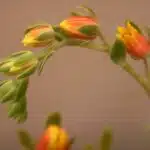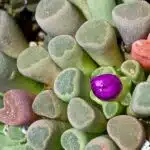When it comes to creating a dazzling display of color and texture in the home, it is hard to beat the String of Rubies. This trailing succulent plant has vibrant pink-red foliage that looks like rubies glimmering in the sunlight. It is a low-maintenance plant that can thrive indoors or outdoors, making it a perfect addition to any garden or living space. With proper care and growing conditions, this exotic succulent can become a true showstopper in your home.
The String of Rubies (Curio rowleyanus) is an ornamental succulent that originates from South Africa. It makes an excellent houseplant due to its ability to tolerate drought and humidity levels, as well as its ease of propagation and relatively slow growth rate. The richly colored foliage is perfect for adding a touch of drama to any room in your home.
Despite its beauty, the String of Rubies requires some special care in order to thrive indoors for extended periods of time. This guide will provide you with all the information you need on how best to care for and grow your String of Rubies so that you can enjoy its beauty for years to come.
Overview Of String Of Rubies
String of Rubies is like a precious gem, sparkly and stunning, bringing life and vibrancy to any space. It is an alluring succulent that thrives in warm, dry climates, asking for little more than adequate drainage and occasional pruning to help keep it looking its best. As with any living thing, understanding its needs will ensure success in growing these beauties.
Caring for String of Rubies requires a few simple steps. They prefer partial sun or full shade and require little water; however, they can also tolerate some light watering during the hotter months of summer. Pruning them regularly will encourage new growth and help keep their stems from becoming too long and brittle. Additionally, string of rubies needs soil with good drainage so it does not become overwatered. A mix of equal parts peat moss and sand works well in providing the drainage needed while still allowing the plant to retain moisture when necessary.
String of rubies is a rewarding succulent to add to your garden or home due to its unique beauty and minimal care requirements. With a bit of knowledge about its needs, this gorgeous foliage can thrive almost anywhere, adding vibrant life to any environment it takes root in.
Where To Find String Of Rubies
“A stitch in time saves nine.” It’s true for everything, including cultivating the precious String of Rubies plant. If you want to enjoy its beauty and reap its benefits, it pays to understand where and how to find it. Here’s a quick guide:
Garden Centers: The best place to get String of Rubies is your local garden center or nursery. You can ask the staff for the varieties available and choose one that suits your growing conditions best.
Online Vendors: You can also purchase String of Rubies from online vendors who specialize in succulents and exotic plants. Some sites even offer packs with several varieties that are easy to cultivate and maintain outdoors or indoors.
Propagation from Cuttings: If you know someone who grows this plant, you can get rooted cuttings from them for free or at a nominal cost. This is an excellent way to start your own collection as cuttings root easily with minimal care and attention.
With the right knowledge and resources, finding the perfect String of Rubies is just a matter of time! Next up, let’s look at what climate and temperature requirements need to be taken into account when caring for this unique succulent plant.
Climate And Temperature Requirements
When it comes to String of Rubies, the climate and temperature requirements are nothing short of extreme. As a specialist in botany and gardening, I can tell you that these delicate succulents need a perfectly balanced environment in order to thrive.
So what conditions should you create in order to give your String of Rubies the best possible chance at success? Here are a few key points:
- The ideal temperatures range between 65-75 degrees Fahrenheit during the day and 55-65 degrees Fahrenheit at night.
- It requires high humidity (at least 50%) and good airflow throughout its environment.
- It needs full sun for six hours each day with some partial shade during the hottest part of midday.
- Watering should be done only when the soil is completely dry; overwatering can cause root rot or other issues.
These conditions may seem intimidating, but don’t worry – by providing your String of Rubies with proper care and attention, you’ll be rewarded with beautiful blooms! And once you’ve mastered these basics, you’re ready to move onto the next step: ensuring your succulent gets enough sunlight each day…
Sunlight Requirements
When it comes to growing String of Rubies, sunlight requirements are a fundamental consideration. The plants need plenty of bright, indirect light in order to thrive. However, too much direct sun can lead to scorched leaves and wilting – so finding the right balance is key.
String of Rubies performs well in windows with southern or western exposure, as long as the sun is filtered by a sheer curtain. Alternatively, you can place the plant near a window that receives strong, indirect light from the east or west side. Placing the plant several feet away from windows with south-facing exposure can help ensure that it isn’t getting too much direct sunlight.
It’s also important to keep an eye on how much light your String of Rubies is receiving throughout the year. In summer months when days are longer and brighter, you may need to adjust its position away from direct sunlight or move it closer to a window with filtered light. In winter months when days are shorter, you may need to move it slightly closer to a window for more light.
TIP: Adjust the position of your String of Rubies regularly throughout the year depending on your climate and amount of natural light available in your home! This will ensure that your plant gets just enough sun and stays healthy and happy!
Watering Requirements
Have you ever wondered how to properly water your String of Rubies plant? As a specialist in botany and gardening, I’m here to give you the answer!
Watering your String of Rubies is essential for their health and growth. This succulent requires well-drained soil, so it’s important that you don’t overwater it. To prevent root rot, let the soil dry out completely between waterings. You can also use a moisture meter to check the soil moisture level and make sure it’s not too wet.
Make sure to water evenly around the entire plant when watering. You want to avoid placing too much or too little water on one side, as this can cause the plant to become unbalanced. Additionally, try not to get any water on the leaves of the plant; this can cause damage and foster bacteria growth.
By following these tips, you’ll have healthier plants with fewer problems over time. With proper watering techniques, you can keep your String of Rubies happy and healthy for many years to come! Now let’s move onto soil requirements so we can ensure optimal health for our beloved plants.
Soil Requirements
When it comes to soil requirements, it’s essential to provide String of Rubies with the right kind of soil. As a specialist in botany and gardening, I recommend a well-draining, sandy-loam potting mix. This type of soil should contain loam, sand, and organic matter like peat moss or composted bark. It should also be mixed with perlite or vermiculite for extra drainage.
When repotting your String of Rubies, make sure the new pot has adequate drainage holes — this is key to avoiding root rot. If you’re able to find cactus potting mix or succulent potting soil, that would be ideal for your String of Rubies as well. The key here is to provide optimal drainage for your plant so its roots can breathe and develop properly.
Once you’ve chosen the right soil for your String of Rubies, fill the container about two-thirds full with it and then press down lightly before adding more soil until it’s filled up completely. After filling the container with enough soil, water it before planting your String of Rubies and let any excess water drain away from the bottom. With these simple steps in mind, you’ll be able to provide your plant with healthy growing conditions!
Now that we’ve discussed what kind of soil is most suitable for this beautiful houseplant species, let’s move on to fertilizing requirements and how they affect its growth.
Fertilizing Requirements
Fertilizing requirements are essential for the health and growth of String of Rubies. Fertilizing helps to provide the necessary nutrients that the plant needs in order to remain vigorous and healthy. An appropriately balanced fertilizer should be applied every two weeks during its active growing season, from late Spring through Summer.
It’s important to avoid over-fertilizing, as this can damage roots and cause leaf burn. The best way to ensure the correct amount of fertilizer is used is to use a product that has been specially formulated for succulents. This will ensure that you’re providing just enough nutrients without giving it too much or too little.
Additionally, it can be beneficial to mulch around your String of Rubies with a layer of organic material. Mulching helps to retain moisture, which can help keep your String of Rubies hydrated throughout periods of drought or intense heat. With proper care and attention, your String of Rubies will thrive and reward you with its beautiful foliage and colorful blossoms. Now let’s take a look at pruning requirements for this stunning succulent!
Pruning Requirements
Surprisingly, pruning requirements for string of rubies plants are minimal. As a Specialist in botany and gardening, I have found that this plant requires only occasional trimming. This is because they tend to look their best when bushier, rather than having thin stems.
One of the benefits of this low-maintenance plant is that it can be easily shaped. To keep your string of rubies looking its best, you should trim off any dead or dying leaves before they can spread disease throughout the plant. You should also remove any stems that are growing too long or thin, as these can disrupt the overall balance of the plant’s shape.
To maintain a fuller and healthier plant, you will need to prune away any stems that are not producing new growth on a regular basis. This will help promote more abundant foliage and blooms in the future. All in all, pruning your string of rubies is an easy task and will result in a beautiful and healthy houseplant!
Propagating String Of Rubies
Propagating String of Rubies is a great way to create more plants for your garden. This trailing succulent has the unique ability to propagate itself through stem cuttings, making it easy to create new additions to your garden. Here are the steps you’ll need to take in order to successfully propagate your String of Rubies:
Begin by taking stem cuttings from an existing plant. Make sure each cutting is at least 6-8 inches long and contains some leaves. You can then either lay them out on a paper towel or place them into a glass of water.
Allow the cuttings to callous for about one week before planting them in soil. During this time, make sure the cuttings stay out of direct sunlight and water them sparingly.
Plant the calloused stems into well-drained soil that contains coarse sand, perlite or other organic matter. Place them in an area with bright but indirect light and maintain an even moisture level in the soil by checking it regularly with your finger.
After several weeks, new roots should begin forming at the base of each stem cutting, signaling that they are ready for transplanting outdoors or into individual pots. With proper care and maintenance, these newly propagated plants should start growing and maturing within a few months’ time!
Propagating String of Rubies is a relatively easy process that anyone can do – all you need is patience and dedication! With some effort and careful attention, you will be rewarded with multiple healthy plants that will bring joy and color to your garden for years to come! But just like any other plant, String of Rubies still needs proper care and maintenance in order to stay healthy; next we’ll discuss common problems as well as solutions for keeping your plants looking their best.
Common Problems And Solutions
Common problems and solutions is an integral part of caring for the String of Rubies plant. With proper care and maintenance, this unique succulent can provide years of pleasure with its bright foliage and dainty foliage. In fact, over 95% of all succulents will thrive if given the right environment, making them a low-maintenance option for any home.
As with any plant, String of Rubies plants can experience growth issues due to environmental conditions or imbalanced nutrition. Common problems include under-watering, poor drainage, pests, insufficient lighting and too much fertilizer. Luckily, most of these can be solved with simple fixes.
First off, it’s important to make sure that the soil is well draining and that you water your String of Rubies sparingly but consistently. Too much or too little water can cause root rot or cause leaves to wrinkle up. If you notice yellowing leaves or stunted growth caused by insufficient light levels then consider providing your plant with some added sun exposure in a spot that gets plenty of indirect sunlight during the day. Additionally, pests such as mealy bugs or aphids should be treated immediately with organic insecticide so they don’t damage your String of Rubies further. Finally, fertilizing your String of Rubies once every 3-4 months is recommended to keep it healthy and vigorous – just remember not to use too much!
In order to ensure that your String of Rubies stays healthy for many years to come it’s essential to troubleshoot any potential problems quickly and take corrective action. With proper care and attention you’ll be able to enjoy your beautiful succulent for years down the line! Moving on from here we’ll discuss container growing tips for successfully cultivating this unique houseplant in pots indoors.
Container Growing Tips
Container gardening is like a chess game; there are numerous considerations that need to be taken into account before making the best move. And when it comes to growing String of Rubies, container gardening requires special attention. Here are a few tips to help ensure success:
- Choose an appropriate sized pot and fill it with well-draining soil. String of Rubies should not be planted in too big of a pot, as this can lead to overwatering and root rot.
- Place the pot in a spot where it will receive partial sun throughout the day. Too much direct sunlight can cause the leaves to wilt, while too little light can prevent flowering and proper growth.
- Make sure to water regularly, as this succulent needs regular moisture, especially during its active growth period in spring and summer.
Though container gardening for String of Rubies may seem daunting, following these simple steps will help ensure that your plant remains healthy and grows successfully over time. With proper care and knowledge about suitable companion plants – which will be discussed in the next section – you’ll be able to create an attractive display of miniature rubies that thrive in your home or garden.
Suitable Companion Plants
String of Rubies is an eye-catching succulent plant, with over 120 varieties that make up their genus. It’s no surprise that they are a popular addition to garden beds and containers, as they require very little maintenance. In fact, almost 10% of the world’s succulent plants come from the String of Rubies family!
When considering companion plants for your String of Rubies, there are several factors to consider. Firstly, you must choose plants which will thrive in similar conditions – so look for drought tolerant species such as Sedums or Sempervivums. Secondly, it is important to select plants which won’t compete for nutrients – this means avoiding other succulents. Finally, you should select plants which have different growth habits than your String of Rubies – for example, grasses or herbs can provide interesting contrasts and textures.
With these tips in mind, you can create an aesthetically pleasing arrangement where all your companion plants will be able to thrive alongside your String of Rubies. While different climates and soil types will influence the type of companion plants you use, with a bit of research and trial-and-error you should be able to find the perfect combination for your garden. Now that we’ve discussed suitable companion plants for String of Rubies, let’s take a look at how we can protect them from pests and diseases…
Pests And Diseases
As with many succulents, pests and diseases can be a potential problem for String of Rubies. It is important to identify any pests or disease early so that they can be addressed quickly and effectively. Common pests include aphids, mealybugs, and whitefly, while common diseases include stem rot, leaf spot, and powdery mildew. To prevent infestations from occurring in the first place, it is important to ensure that the soil is well-draining and that the plant is not overwatered.
In addition to regular monitoring for signs of pests and disease, it is also important to keep an eye out for signs of stress in your String of Rubies. Overfertilizing or underwatering can cause stress which can make the plant more susceptible to pests and disease. If you notice any signs of stress such as wilting leaves or discoloration, take immediate action to address the issue.
To keep your String of Rubies healthy and thriving, it is important to take steps to prevent pest infestations and treat any diseases that may arise quickly and effectively. With proper care and monitoring, you will be able to enjoy your String of Rubies for years to come! Now let’s discuss winter care – an important topic when growing this type of succulent indoors!
Winter Care
The winter care of string of rubies is a critical step in ensuring the success of your plants. While the plant can survive cold temperatures, there are several factors to consider for optimal growth and flowering. First, it’s important to note that string of rubies will go dormant in winter months and stop growing. This means that any pruning or fertilizing should be done before the cold weather sets in.
Second, when temperatures drop below 50 degrees Fahrenheit, you may need to provide extra protection for your plants. If conditions are too severe, you can cover your plants with mulch or other organic materials like straw. You should also move containers indoors if possible to protect them from extreme cold temperatures outside.
Finally, you should continue providing adequate water during the winter months if temperatures remain above freezing. Make sure to check on your plants regularly and adjust water levels as needed based on their condition. With proper care and consideration during the winter months, your string of rubies will grow robustly and flower brightly come springtime!
Harvesting String Of Rubies
Did you know that the String of Rubies plant can produce up to 20 flowers in a single season? This is an incredible number, and demonstrates the sheer beauty of this special plant. As a specialist in botany and gardening, I’m here to tell you about harvesting String of Rubies.
The harvesting process for String of Rubies is relatively straightforward. To begin, determine when the flower’s petals have dropped off, as this is generally a sign that they are ready to be harvested. Once you’ve decided that the flowers are ready, carefully cut them off with a pair of scissors or snips. Be sure not to damage any branches or leaves while doing so! Next, hang the flowers upside down indoors in a dark room until they have completely dried out. This should take about two weeks.
Once the flowers have dried out, all that’s left to do is enjoy their beauty! You can place them in small displays around your home or give them away as gifts – either way, there’s no doubt that these unique blooms will bring joy to those who behold them. Plus, it’s a great feeling knowing that you grew them yourself!
Frequently Asked Questions
Is It Possible To Grow String Of Rubies Indoors?
Growing string of rubies indoors is a possibility that many gardeners may want to consider. These plants, with their delicate tendrils and ruby-red leaves, can look beautiful cascading from hanging baskets or on bookshelves. In fact, one customer reported that they had grown a beautiful string of rubies in an indoor setting that was thriving and full of life!
When it comes to growing these plants indoors, there are some key considerations to take into account. Firstly, the amount of direct sunlight should be limited; too much sun can cause the leaves to become scorched and discolored. Secondly, it’s important to keep the soil consistently moist but not soggy; otherwise, the plant could suffer from root rot. Finally, regular misting is recommended as this will help keep their foliage looking vibrant and healthy.
For botanists and gardeners alike, growing string of rubies indoors can be extremely rewarding when done correctly. The trick is to give them just enough light, water, and humidity for them to thrive without causing any damage or harm. With patience and love for your little green friends – you’ll be able to enjoy their beauty all year round!
How Often Should I Water My String Of Rubies?
Growing a String of Rubies can be an incredibly rewarding experience. It’s like nurturing a precious gem, with its glossy foliage and cascading vining habit. Providing the right care for this magnificent succulent is a must to ensure its beauty and health. One of the most important factors is how often you water your plant.
When it comes to watering your String of Rubies, less is more! Overwatering can cause root rot, leading to wilting or leaf drop. It’s best to give your plant just enough water so the soil is barely moist. Here are some tips on how often and when to water:
- Water twice a week in summer when temperatures are warm and days are longer;
- Reduce watering frequency to once every two weeks during cooler months;
- Check the soil moisture before watering – if it feels dry then give it a drink, otherwise wait until next time;
- Avoid getting the leaves wet as this can lead to fungal diseases;
- If your plant is located in direct sunlight, increase watering frequency slightly as they will dry out faster;
- Provide extra humidity by misting around the leaves or keep the pot on top of a tray filled with pebbles and water.
By following these simple guidelines you can ensure that your String of Rubies will thrive for years to come. With regular attention and proper care, you’ll be able enjoy its captivating beauty for many years!
Do I Need To Use Special Fertilizer For My String Of Rubies?
Cultivating a string of rubies can be an exciting and rewarding experience for any gardener. Like any other plant, however, it requires special care in order to thrive. To ensure your string of rubies is healthy and vibrant, you should pay particular attention to its fertilizer needs.
The key to success with a string of rubies is providing the right kind of fertilizer. Here are a few tips to keep in mind when deciding which fertilizer to use: • Look for a balanced fertilizer with an N-P-K ratio that is slightly higher in phosphorus than nitrogen and potassium • Avoid using too much nitrogen-heavy fertilizer • Select organic fertilizers over chemical ones whenever possible • Read the label carefully for instructions about how often and how much fertilizer to use • Start with small doses and increase gradually if needed.
As an expert botanist, I understand that proper nutrition is essential for the health of your plant. Providing your string of rubies with the right kind of fertilizer can help ensure it will remain lush and vibrant over time. With careful consideration and attention, your string of rubies will blossom into an eye-catching addition to your home or garden!
Is It Necessary To Prune My String Of Rubies?
Pruning your string of rubies is an important task that requires a delicate touch. It’s not something you should rush into, since it can damage the unique foliage of this succulent. To illustrate the importance of careful pruning, consider the story of a gardener who was growing string of rubies for many years in her backyard. As she watched them grow, she noticed that the stems started to get longer and more unruly and knew it was time to prune. She carefully snipped off only the longest branches, and within weeks her plant looked much fuller and healthier!
When pruning your own string of rubies, it’s important to remember that these plants respond best to gentle care. They don’t require much attention overall, but they do need some occasional maintenance – like trimming long stems or removing dead leaves – to keep them looking their best. Use scissors or garden shears to make clean cuts at the base of each stem, just above where it meets the soil. Take care not to cut too deeply into the stem or leave any jagged edges behind.
It’s also essential to avoid overwatering your string of rubies; too much moisture can cause root rot and other problems that can be hard to reverse without professional help. If you stick with a regular watering schedule and provide plenty of indirect sunlight, you’ll find that your plant will thrive and look its best with minimal effort from you. Pruning is an important part of caring for any succulent, but especially so for string of rubies given its unique growth habits!
What Are The Best Companion Plants To Grow With String Of Rubies?
As you bring the beautiful, cascading String of Rubies into your home, you may be wondering what other plants can thrive alongside it. This succulent is an eye-catching addition to any garden and it’s important to pair it with the right companion plants. With careful selection and proper care, you can create a vibrant display that will captivate all who observe it.
Imagining yourself in a flourishing paradise of greenery, you’ll soon realize that there are many possible companions for your String of Rubies. From trailing ivy and creeping sedums to bright daisies and petunias, the possibilities are only limited by your imagination. Depending on the size of your garden or window box, you can select combinations of flowers and foliage to best complement the ruby hues of your succulent.
To ensure that each plant receives enough sunlight and water, research their individual needs before planting them together. Once everything is in place, take time to appreciate the beauty of nature’s bounty as it radiates from your creation. As an experienced gardener or botanist, this is a task that brings great joy to both yourself and those around you – the perfect reward for a successful combination of companion plants!
Conclusion
String of Rubies is truly a unique and versatile houseplant. It’s easy to care for and its beauty can bring life to any room. With a few simple steps, you too can enjoy the vibrant display of ruby-red beads that this plant provides.
Watering and fertilizing your String of Rubies regularly is essential for its health, but it’s also important to remember that too much water or fertilizer can cause harm. Pruning your plant occasionally will help to keep it looking fresh and vibrant, as well as encourage new growth. Additionally, consider pairing your String of Rubies with other plants in order to create an even more vibrant display of life in your home.
As you nurture and grow your String of Rubies, you will experience nothing short of pure magic! Not only does this stunning houseplant bring a burst of color into any room, but it also has the power to turn any space into something extraordinary! To experience true joy within the comfort of your own home, be sure to get ahold of a String of Rubies today!





























